Plantation shutters are more than just window coverings; they are timeless, architectural elements that add significant value and character to your home. You’ve invested in their beauty and quality, and keeping them looking pristine is simpler than you might think. Worried you need a professional shutter cleaning service? The great news is that with the right materials and our expert techniques, you can achieve a professional-level clean all by yourself.
The timeless look of plantation shutters is always in style and these prized coverings have been proven to add long-term value to your windows. Their impeccable craftsmanship inspires upscale design that can still feel like home. However, these wonderful window treatments won’t do you any good if they’re constantly covered in dust. Fortunately, shutters don’t require an enormous amount of upkeep and are surprisingly easy to clean. Modern vinyl versions are even easier to tidy up, but I’ve got tips that will work for traditional wood or faux wood versions, too. Before you know it, they’ll be as elegant and impeccable as they were when they were first installed.
As a family-owned company with over 25 years of experience handcrafting window treatments, we know exactly what it takes to care for them. Let’s walk through the simple steps to clean your plantation shutters, so they continue to be a stunning feature in your home for years to come.
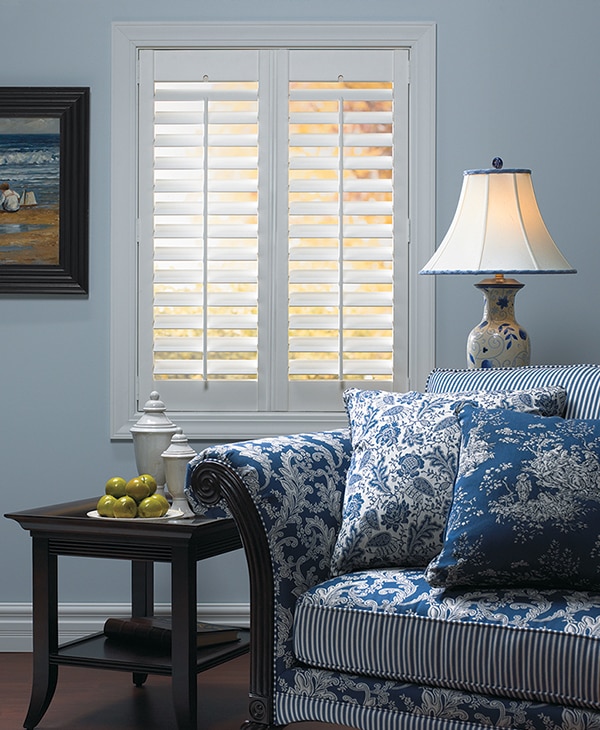
First: Know Your Shutters & Gather Your Tools
The first step to a safe and effective clean is knowing your shutter material. The method for cleaning wood shutters is different from that for more durable composite or poly-resin shutters.
- Wood Shutters: These offer unparalleled natural beauty but are more sensitive to moisture. They require a gentle touch to protect their finish.
- Poly-Resin / Vinyl Shutters: These are incredibly durable and moisture-resistant, making them perfect for high-humidity areas like kitchen shutters and bathroom shutters. Our Blindsgalore Simple Shutters are crafted from a high-quality poly-resin that won’t warp, crack, or fade, making them exceptionally easy to clean.
What You’ll Need:
- A few clean microfiber cloths
- A feather duster or a soft-bristled brush
- Your vacuum with the soft brush attachment
- A bowl or spray bottle
- Mild dish soap
- (Optional) White vinegar, an old toothbrush
Crucial ‘Don’ts’: What to Avoid When Cleaning
In our 25 years of experience, we’ve learned that preventing damage is the most important part of cleaning. To protect your investment, please avoid these common mistakes:
- ❌ Do NOT use excess water on wood shutters. This is the number one rule. Too much moisture can cause the wood to warp, swell, or stain, leading to permanent water damage.
- ❌ Do NOT use harsh chemical cleaners, ammonia-based sprays, or abrasive scrubbers. These can strip the paint or finish from your shutters, causing discoloration and damage.
- ❌ Do NOT use furniture polish on your shutters. While it might seem like a good idea, many polishes contain silicones that can create a sticky film, attracting even more dust and grime over time.
- ❌ Do NOT use a “Magic Eraser” on wood shutters. These are fine abrasives and can damage the finish. They may be used very gently on some poly-resin shutters for stubborn spots, but always test on an inconspicuous area first.
Level 1: The Quick & Easy Dusting (Weekly Maintenance)
The best way to keep your shutters looking flawless is with a quick, regular dusting. This prevents the buildup of dust, allergens, and pet hair.
- Open the Louvers: Tilt the louvers to a fully open position.
- Dust Them Down: Use a feather duster or a dry microfiber cloth to wipe down each louver individually. Work from the top down so dust falls away.
- Close and Repeat: Close the louvers so they face up, and dust them again. Then, close them so they face down and give them one final wipe. This ensures you get every surface.
- Vacuum (Optional): For an even faster clean, use your vacuum’s soft brush attachment. With the louvers closed, gently run the brush over the shutters. This is excellent for quickly removing dust and cobwebs.
Level 2: The Deep Clean for a Deeper Grime
When dust turns into a layer of grime or you notice smudges and fingerprints, it’s time for a slightly deeper clean. The method varies by material.
Faux Wood Shutters
A vacuum cleaner and a feather duster will be your most useful tools when cleaning your faux wood plantation shutters. While faux woods may stand up to a little water, it is always best to use a dry method to avoid accidentally damaging your shutter. Start with a normal feather duster to remove any excess filth that may have built up along the slats and edges. Next, use the brush attachment of your vacuum cleaner to pick up anything your regular duster might have left behind. This powerful 1-2 combination is a sure fire way to keep your faux wood sparkling.
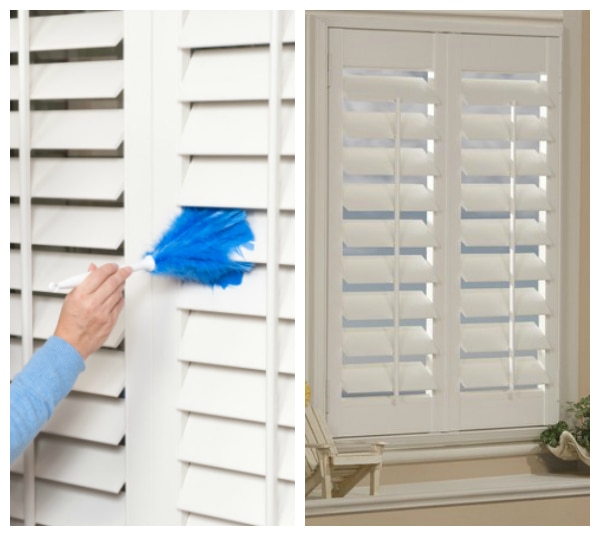
How to Clean Wood Shutters
Real wood shutters are a little more fragile than their faux or vinyl counterparts. I highly recommend avoiding any water or harsh chemicals that may warp, scratch, or discolor your real wood plantation shutters. A regular dusting is likely all these window treatments will require, identical to the method described above. Get your feather dusters and vacuum cleaners ready, as those will always be your most practical cleaning options. For an added bonus, swipe each slat with a spare dryer sheet after dusting. Not only will the dryer sheet pick up anything left behind, but it will also help prevent any future dust from building up.
Remember, water is not your friend here. The key is a damp cloth method, not a wet one.
- Dust First: Always give the shutters a thorough dusting before introducing any moisture.
- Prepare Your Solution: Mix a solution of lukewarm water with a tiny drop of mild dish soap. Alternatively, a vinegar and water solution (one part white vinegar to two parts water) is a great natural cleaner.
- Dampen, Don’t Soak: Dip a clean microfiber cloth into the solution and wring it out until it is almost dry. It should feel damp to the touch, with no dripping water.
- Wipe Gently: With the louvers closed, gently wipe them down. Follow the grain of the wood if it’s visible.
Dry Immediately: Use a separate, clean, and completely dry microfiber cloth to wipe away any remaining moisture. Do not let the shutters air dry.
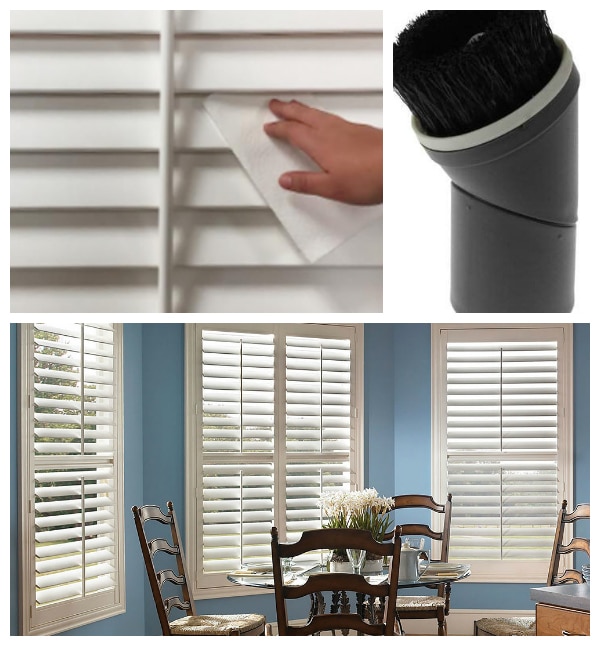
How to Clean Poly-Resin and Vinyl Plantation Shutters
Both waterproof and flame retardant, vinyl shutters are among the most tenacious window treatments. While these robust coverings may stand up to water and harsh chemicals, I still don’t recommend using them unless your frame or slats have become stained. Even then, if your vinyl shutters are in need of a deep clean, I’d suggest using a little bit of white vinegar on a sock or glove instead. Other than that, a semi-regular dusting should be all they need to stay tidy.
These durable shutters can handle a bit more moisture, making them easier to deep clean.
- Dust First: Give the shutters a quick dusting to remove any loose debris.
- Wipe Down: You can use the same damp cloth method as with wood, but you can be a bit more liberal with the water. A soft sponge also works well here.
- Rinse (If Needed): If you used a soapy solution, go over the shutters one more time with a cloth dampened with only plain water to remove any residue.
- Dry Thoroughly: While poly-resin is water-resistant, it’s still a good practice to wipe the shutters dry with a clean cloth to prevent water spots and keep them looking perfect.
Level 3: Tackling Stubborn Spots and Stains
For those extra tough spots, like grease in the kitchen or built-up grime, you may need to do some spot cleaning.
- Make a Paste: For stubborn spots on either wood or poly-resin, a baking soda paste can work wonders. Mix a small amount of baking soda with a few drops of water to form a paste.
- Apply Gently: Using your finger or a soft cloth, gently apply the paste to the stain.
- Wipe Away: Let it sit for a minute, then gently wipe it away with a clean, damp cloth. Be extra gentle on wood shutters and always test on a hidden area first.
- Dry the Area: Immediately dry the spot with a clean cloth.
Don’t Forget the Details: Hinges and Corners
To get that truly professional-level clean, pay attention to the small details. Use a dry, soft-bristled brush or an old toothbrush to gently whisk away dust from the hinges and tight corners where the louvers meet the frame.
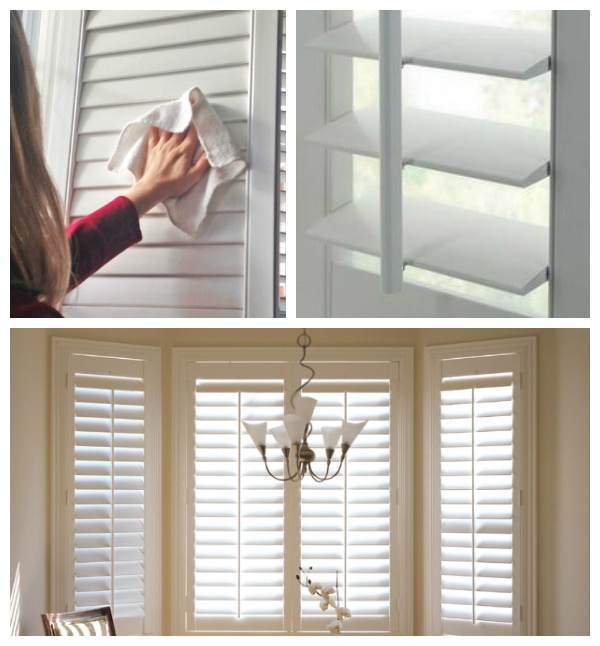
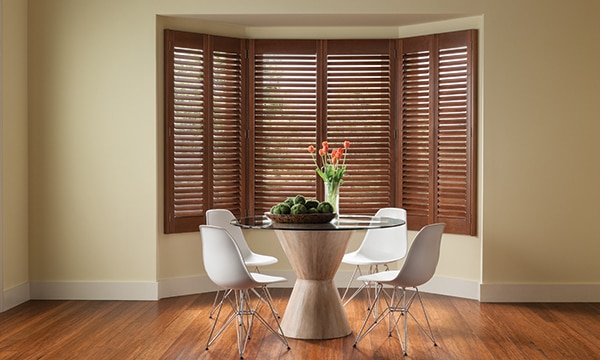
Featured Image: KTOZ Blinds
These top-of-the-line window treatments are an undeniable favorite and modern manufacturing practices have increased their durability to make them a perfect choice for any room. By following these easy tips, you can get your shutters looking as good as they did on day one. I personally recommend cleaning your plantation shutters regularly, even if they don’t look dirty, to cut down on any extra grime or debris. That way, you can avoid any long-term problems and can instead enjoy the long-lasting look of these window coverings. Long live the plantation shutter! Shutters are a perfect solution if you’re looking for both a durable and timeless window treatment.
Our Family Promise
As a family-owned business, we stand behind every product we craft. That’s why our Blindsgalore products come with a free 3-year warranty against any defects in materials or workmanship. We build our shutters to last, using high-quality materials that make the cleaning and maintenance we’ve described here that much easier. If you ever have a question, our in-house team of friendly window experts is here to help.
Frequently Asked Questions
Yellowing is often caused by direct, prolonged exposure to harsh sunlight or buildup from grease or smoke. Regular dusting and cleaning, especially in kitchens, is the best prevention. High-quality poly-resin shutters are also formulated to be UV resistant.
The fastest method is to close the louvers and use a vacuum with a soft brush attachment. A large feather duster that can cover multiple louvers at once is also very quick for light, regular dusting.
We advise against it. Many pre-moistened wipes contain chemicals or oils that can damage the finish on wood shutters or leave a residue on poly-resin that attracts more dust. A simple damp microfiber cloth is always safer and more effective.
For moisture-resistant poly-resin shutters, you can use a solution of equal parts white vinegar and water. Apply with a cloth or soft brush, let it sit for a few minutes, then wipe clean and dry thoroughly. Never let mould sit on wood shutters.
While there are special multi-pronged “shutter duster” tools available, we find that a simple, high-quality microfiber cloth or a vacuum brush attachment works just as well, if not better, and you already have them at home.

